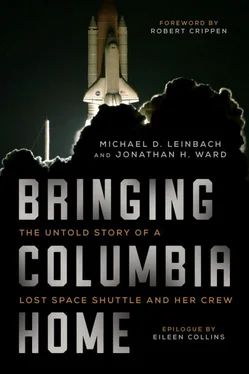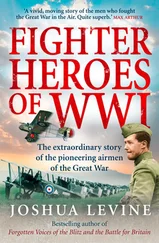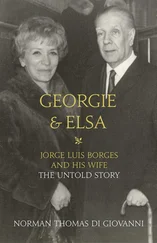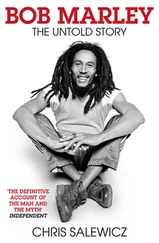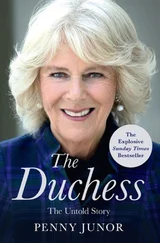We briefed the spouses in advance to prepare them for what they would see. To make the atmosphere as private as possible, only a few of the staff were on hand when the spouses arrived with their astronaut escorts. I greeted them at the entrance, and Steve Altemus escorted them through the hangar.
Lani McCool was interested in Columbia ’s cockpit window frames. She asked me about the windows and where her husband Willie was sitting during reentry. I told her, “As the pilot, he would have been sitting on the ship’s right side.”
She asked, “So, he was behind these windows?”
I said, “Yes, that’s where he would have been.” She then reached into her bag, pulled out a flower lei, and placed it behind a window.
Then it got tough. She asked me point-blank, “What do you think Willie knew?”
I said, “I don’t know. Lani—your husband was one of the best pilots in the world. He knew if he had an aircraft that was in control or not. I’m sure that at some point, he knew he was in trouble.” She thanked me for being straight with her.
The spouses returned a few weeks later for another visit, this time with some of their children. [8] Interview with Robert Hanley.
The children were at first reluctant to enter and had to be encouraged to come into the hangar. John Biegert and Robert Hanley escorted them through the crew module area. “For me, it was the most emotional time in the whole process,” Biegert said. “The kids just wanted to hold or touch something that their mom or dad had touched or had been near. We had built up the seats as best we could, and had the flight equipment and hand controllers and switch panels. It was hard for them to see that, but they felt that they had to do it. Some of the kids came back five years later, and I took them through the crew module again.”
The families appreciated being able to see what had happened to the orbiter. They also witnessed the reverence and care with which we were treating the vestiges of Columbia —and the lengths to which NASA had gone to understand and learn from the accident—to ensure that future space travel would be safer because of the sacrifices of Columbia ’s crew.
In July, we opened the reconstruction hangar to all KSC workers and their families. We saw it as an opportunity “to educate and inform, give us a new respect for space exploration and those who serve, and allow closure to this tragedy in some ways.” [9] “Debris Reconstruction Hangar Walk-through Days Scheduled,” Spaceport News , June 27, 2003, 2.
We also knew it was important for the people who had been deployed to the recovery operations in Texas to see the results of their labors.
Many workers at KSC felt a sense of guilt over the loss of the shuttle, perhaps feeling they had somehow contributed to the accident or failed to prevent it. Emotions were still raw. Even the women who sewed the quilted fabric insulation blankets for the shuttles thought they might have caused the accident. “I had to personally go out there and let them know that they were not responsible for this loss. They were really upset about it,” said Roy Bridges, who was KSC center director at the time.
We set aside Monday through Wednesday, July 7 through 9, for KSC personnel to visit the hangar. Then KSC employees and their families were permitted to visit between three and eight o’clock on Thursday and Friday, and all day Saturday. I sat at the entrance to the hangar and personally greeted every visitor—eleven thousand people by the end of the week. It was tough going for an introvert like me, but I felt they needed to see a familiar face when they arrived in that unsettling environment. NASA, Boeing, and United Space Alliance employees were on hand to answer questions about the debris on the hangar floor, the test processes, and our conclusions about the accident. The Sixteen Minutes from Home video commemorating Columbia and her crew played at a screen off to one side of the hangar. The video never failed to touch people’s hearts.
We stationed several employee assistance counselors throughout the hangar to help folks who were emotionally overwhelmed by the sight of Columbia ’s wreckage. And indeed, a few people became distraught when the sight of the debris proved too much for them to bear. Even my wife Charlotte was startled at the powerful impact of the remains of the ship. She said, “I knew what the windows looked like, and I knew they were around the corner, but you just can’t imagine it until you see it. You think you can imagine it, but you can’t.”
It was a remarkable opportunity for the greater KSC family to appreciate what they had accomplished in months of sacrifice and hardship, and to welcome their old friend Columbia back home one last time.
On Sunday, July 10, we conducted a private tour for the families of the women and men who had been working in the hangar for the past five months. Steve Altemus said, “The wives and husbands and sons and daughters of whoever was working in the hangar now suddenly got a sense of what their mom or dad was working on for so many hours for four months. Here’s what they were doing and why it was important.”
In contrast to the rapid, nearly instantaneous start-up of activity in the hangar in February, the reconstruction effort tailed off gradually during the early summer. Groups closed out their areas and moved on.
I gathered with some of my closest associates on the management team on the runway apron outside the hangar entrance near the end of July. I made a special request to the Center director for our team to have a couple of beers that evening. That was unheard of. You just didn’t bring alcohol to “officially” drink on KSC grounds. We swapped stories, pined away at the thought of this phase of our association nearing an end, and toasted one another using space shuttle shot glasses that Jon Cowart supplied for the occasion. Then we drank a toast to Columbia and her crew, and poured a bottle of Scotch onto the runway.
On August 12, Roger and Belinda Gay, accompanied by their son, daughter, and several other relatives and friends, came from Hemphill to Kennedy Space Center as guests of NASA to tour the reconstruction hangar and see the shuttle processing facilities. The Gays spoke to workers at KSC, relating their account of the amazing events of early February and speaking of the bond that quickly formed between the citizens of Hemphill and the NASA family.
The Gays said that the Sabine County community was discussing plans to build a memorial to Columbia and her crew, the helicopter crew who perished during the search, and the community’s volunteer effort. Texas A&M University architecture students were already developing preliminary designs for consideration.
Visiting the reconstruction hangar brought the whole recovery experience full circle for the Gays. Belinda said, “We needed to come here. Seeing the hangar was a very emotional experience and gave us some sense of closure.” [10] “Texas Family Recalls Recovery Contributions,” Spaceport News , September 5, 2003, 4.
—
Our workforce had endured an incredibly grueling first half of the year. Between the loss of the shuttle and its crew, the hardship of the recovery operations, and the reconstruction, our staff was physically exhausted and emotionally drained. No one knew if or when the space shuttle would fly again. Contractors worried about their job security if the program were to be canceled or scaled back.
By the end of April, I realized our launch team needed a goal in order to push themselves through the grieving process. It was time to get the team back together, operating effectively in familiar surroundings, and focused on flying America’s shuttles again.
Читать дальше
